|
|
 |
|
Calanoida ( Order ) |
|
|
|
Ryocalanoidea ( Superfamily ) |
|
|
|
Ryocalanidae ( Family ) |
|
|
|
Yrocalanus ( Genus ) |
|
|
| |
Yrocalanus antarcticus (Renz, Markhaseva & Schulz, 2012) (F,M) | |
| | | | | | | Syn.: | Ryocalanus antarcticus : Renz & al., 2012 (p.150, Descr.F, M, figs.F, M, Rem.); Andronov, 2014 (p.44, fig.: P1) | | | | Ref.: | | | Renz & al., 2013 (p.258) | 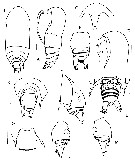 Issued from : J. Renz, E.L. Markhaseva & K. Schulz in Proc. Zool. Inst. RAS, 2012, 316 (2). [p.151, Fig.1]. As Ryocalanus antarcticus. Female (from 73°24'S, 22°08'W): A-B, habitus (lateral and dorsal, respectively); C-D, rostrum (ventral and lateral, respectively); E-F, pedigers 4-5 and urosome (dorsal and lateral, respectively); G, posterior prosome and genital double-somite (dorsal); H, urosome (dorsal); J, urosome (right lateral); K urosome (left lateral); L, posterior prosome and urosome (ventral). Scale bars = 0.1 mm. A, C-D, F, H-K: holotype; B, E, L: paratypes; G: paratype from 52°02'S, 0°00'E.
|
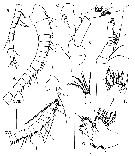 Issued from : J. Renz, E.L. Markhaseva & K. Schulz in Proc. Zool. Inst. RAS, 2012, 316 (2). [p.152, Fig.2]. As Ryocalanus antracticus. Female: A, A1, segments I-XVIII, round dots are scars of broken aesthetasks; B, A1, segments XIX-XXVIII; C, A1, segment I; D, A1, segments I-XVI; E, A2 (coxa, basis and endopod); F, A2 (exopod); G, Mx1; H, Mx1 (praecoxal arthrite, asterisk marks teeth near bases of middle terminal spines; I, Mx1 (coxal endite. A,B: paratype from52°02'S, 0°00'E; paratypes from 73°24'S, 22°08'W; H: holotype. Scale bars = 0.1 mm.
|
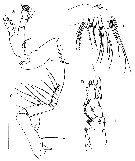 Issued from : J. Renz, E.L. Markhaseva & K. Schulz in Proc. Zool. Inst. RAS, 2012, 316 (2). [p.153, Fig.3]. As Ryocalanus antarcticus. Female: A, Md; B, Mx2; C, Mxp; D, P1. Scale bars = 0.1 mm. A: paratype from 52°02'S, 0°0'E; B-D: paratypes from 73°24'S, 22°08'W.
|
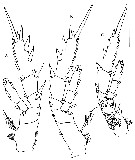 Issued from : J. Renz, E.L. Markhaseva & K. Schulz in Proc. Zool. Inst. RAS, 2012, 316 (2). [p.155, Fig.4]. As Ryocalanus antarcticus. Female: A-C, P2 to P4, respectively.Scale bars = 0.1 mm. A, B: holotype; C, paratype.
|
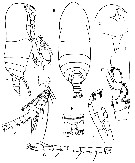 Issued from : J. Renz, E.L. Markhaseva & K. Schulz in Proc. Zool. Inst. RAS, 2012, 316 (2). [p.156, Fig.5]. As Ryocalanus antarcticus. Male: (from 73°24'S, 22°08'W): A-B, habitus (lateral and dorsal, respectively); C, forehead (lateral); D, rostrum (ventral); E, urosomal segment 5 and caudal rami (dorsal); F, left A1, segments I-XVI; G, left A1, segments XVII-XXVIII; H, P1; I, P5. Scale bars = 0.1 mm. Left A1 unmodified of 24 free segments extending to urosome (segments indicated on the figure in Roman numerals are primitive segments).
|
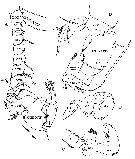 Issued from : J. Renz, E.L. Markhaseva & K. Schulz in Proc. Zool. Inst. RAS, 2012, 316 (2). [p.157, Fig.6]. As Ryocalanus antarcticus. Male (from 73°24'S, 22°08'W): A, right A1, segments X-XXVIII, arrow shows small segment XIX; B, C, right A1, segments XVIII-XX (other views); D, A1, segments XXI-XXVIII (asterisk marks place of attachment of segment XX). Scale bars = 0.1 mm. Nota: Right A1 geniculate, strongly modified, 23 free segments (segments indicated on the figure in Roman numerals are primitive segments).
|
 Issued from : V.N. Andronov in Russian Acad. Sci. P.P. Shirshov Inst. Oceanol. Atlantic Branch, Kaliningrad, 2014. [p.44, Fig.12, 7]. As Ryocalanus antarcticus after Renz & al., 2012. Female P1.
| | | | | NZ: | 2 | | |
|
Distribution map of Yrocalanus antarcticus by geographical zones
|
| | | | | | | Loc: | | | Antarct. (E Weddell Sea), sub-Antarct. (off E Bouvet)
Locality type: 73°24'S,22°08'W. | | | | N: | 1 | | | | Lg.: | | | (1305) F: 1,00-1,05; M: 0,75-0,80; {1,00-1,05; M: 0,75-0,80} | | | | Rem.: | Above seabed (depth: 1983 and 2987 m).
For Renz & al. (2012, p.154 ) the female is more closely related to R. admirabilis (= Yrocalanus admirabilis). This species is the first ryocalanoid copepod recorded from the Southern Ocean. | | | Last update : 20/04/2016 | |
|
|
 Any use of this site for a publication will be mentioned with the following reference : Any use of this site for a publication will be mentioned with the following reference :
Razouls C., Desreumaux N., Kouwenberg J. and de Bovée F., 2005-2026. - Biodiversity of Marine Planktonic Copepods (morphology, geographical distribution and biological data). Sorbonne University, CNRS. Available at http://copepodes.obs-banyuls.fr/en [Accessed January 07, 2026] © copyright 2005-2026 Sorbonne University, CNRS
|
|
 |
 |










